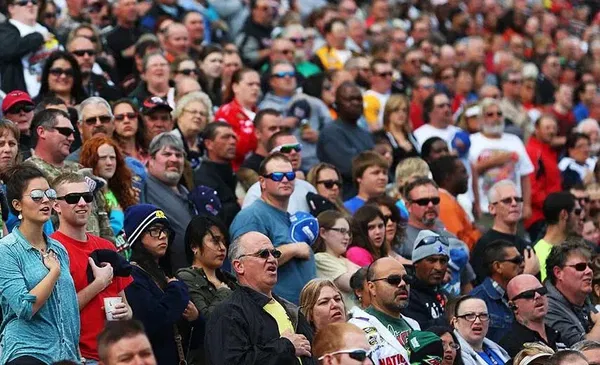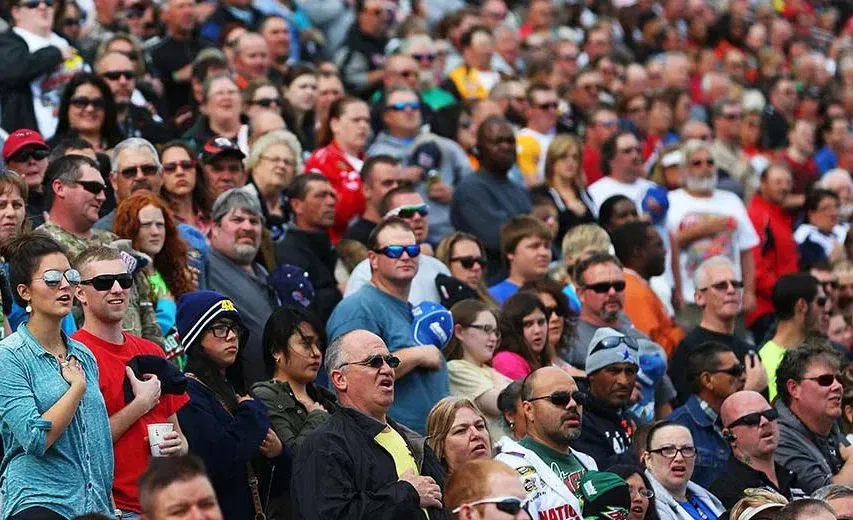
Imago
Via NASCAR

Imago
Via NASCAR
NASCAR’s TV viewership has been on a bumpy decline for well over a decade, and 2025 has brought some of the lowest numbers in its history. Just five years ago, regular Cup races averaged nearly 4 million viewers. Now, that figure has dropped to 2.5 million – a 13% decrease from 2024’s numbers and a staggering drop from NASCAR’s 2005 peak when a single Daytona 500 could command more than 18 million fans.
Watch What’s Trending Now!
This season’s first four playoff races averaged just 1.56 million viewers, far short of the sport’s glory days. As cable subscriptions shrink and younger fans drift away, the issue has become impossible to ignore. Beneath these numbers lies a deeper debate about whether NASCAR’s multi-billion-dollar media deals and dramatic playoff formats are helping (or hurting) the future of stock car racing.
ADVERTISEMENT
NASCAR playoffs TV ratings drop for Charlotte Roval
The press box was buzzing after the Charlotte Roval, but it wasn’t just the daring passes or dramatic playoff heartbreaks making headlines. Adam Stern’s tweet revealed the Bank of America Roval 400 drew a 0.80 rating and 1.54 million viewers on USA Network. So what? Well, this means that viewership was down a staggering 35% from last year’s 2.4 million, which aired on NBC.
Jeff Gluck quickly highlighted the elephant in the room. Remember the $7.7 billion TV deal NASCAR signed earlier this year? FOX, NBC, Warner Bros. Discovery, and Amazon will split 38 races across their channels each year, starting with the 2025 season. Well, thanks to it, NBC is only showcasing four races this season. Yep, it’s just the Daytona cutoff event and the final three playoff rounds airing on NBC. In contrast, most playoff action moves to cable, a network with less reach and weaker numbers.
FWIW, the NBC viewership last year was 2.4 million. With the new TV deal, NBC is only showing four races this year (Daytona cutoff race and the last three playoff races). https://t.co/H8EDL8WTfH
— Jeff Gluck (@jeff_gluck) October 7, 2025
ADVERTISEMENT
The intent behind the premium media contract was clear: secure NASCAR’s future, generate massive revenue, and ensure high-profile exposure for key events. But reality has set in. Playoff viewership, once the crown jewel of NASCAR’s season, is now routinely struggling to break two million viewers. It’s no secret that fall Sundays mean competition with the NFL, but several insiders and fans suggest the network shuffle is also to blame.
And in 2025, NASCAR’s ratings slide is evident across the board. Playoff races have tumbled by nearly 29% year-over-year, now rarely breaking 1.6 million per event. Per an X post of Jeff Gluck, the Kansas playoff race on USA Network only reached 1.49 million viewers, compared to 1.79 million in 2024. On the other hand, the New Hampshire opener was also only 1.29 million, compared to 1.88 million the previous year. In-house rivalries, such as the current contract war between NBCUniversal and YouTube TV, are at risk of causing blackouts to major races, forcing fans to scramble and damaging engagement.
ADVERTISEMENT
With skepticism growing on social media and forums, the next chapter is all about the ‘why.’ Does this new TV landscape serve long-time supporters or leave many behind? That’s the debate racing through the paddock, direct from the heart of NASCAR’s online community.
Fans vent frustration
The outcry from fans was swift as soon as the 2025 Roval ratings hit social media. “2.419 million last year. Down 36%,” one pointed out, referencing the 2024 Charlotte Roval race that aired on NBC. Kyle Larson’s victory drew more than 2.4 million viewers, making it the most-watched Roval race since 2021. This year’s telecast, on USA Network, reached just 1.54 million viewers, reinforcing how shifting high-profile races off major broadcast networks can have immediate negative effects on audience size.
ADVERTISEMENT
Anger quickly shifted to NASCAR’s $7.7 billion broadcasting deal. “NASCAR absolutely shot themselves in the foot with this TV deal. Money man France only cares about the dollars and not about growing the sport…” The reality: NASCAR’s new media deal was designed to secure the sport’s financial future, guaranteeing billions through 2031. However, it has left many questioning whether sacrificing broad visibility and growth for short-term earnings is wise by shifting to multiple broadcasting partners (including streaming services like Prime Video).
Another fan gave three main reasons for flat playoff viewership:
- “USA Network = a lot don’t have it.” Many households lack access compared to NBC’s nationwide reach.
- “Playoffs = too many hate them.” The win-or-go-home drama appeals to some, but traditionalists dislike a champion decided by just a few races rather than season-long consistency.
- “SVG = why bother.” With Shane van Gisbergen dominating yet again on a road course (his fifth win, most ever by a rookie in a modern season), some fans felt the suspense was gone, and the race was a foregone conclusion.
ADVERTISEMENT
“What’s worse, USA Network isn’t easily accessible. Why not put them on Peacock also?” wrote another. With streaming growing, many felt putting playoff races on Peacock, too, would have helped. This comment echoes calls for NASCAR to embrace a broader, more modern digital approach for younger and more mobile fans. Prime Video alone averaged around 2.16 million viewers across five Cup Series races, marking a shift as more fans embrace digital platforms. What is more, the streaming platform’s post-race coverage was also a point of appreciation for the fans.
For some, the only consolation (sarcastic) was: “At least less people were disappointed by the terrible points format, lol.” As mentioned earlier, dislike of the current playoff system remains deep. Many fans and NASCAR veterans want a return to the old format, which crowns a season champion based on consistency, not just clutch performances in knockout rounds. This debate has gained further heat after Joey Logano’s 2024 championship, where we were initially eliminated, but Alex Bowman’s post-race inspection failure gained him entry into the Round of 8, and we all saw how he cruised from there.
As NASCAR prepares to navigate the future of its TV deal and championship structure, it’s clear the sport must balance financial strategy with the passion (and frustration) of its loyal fanbase. The debate rages on: is NASCAR chasing dollars at the expense of its roots, or is this the new normal in a rapidly changing sports media world?
ADVERTISEMENT
ADVERTISEMENT
ADVERTISEMENT

